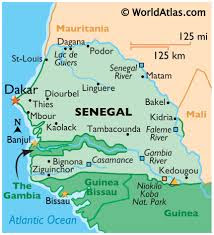Day 128: Dakar, Senegal - Cooking!!
This is our final stop on the mainland of West Africa, so we decided to revert to vacationing instead of traveling and chose two rather more fun excursions. Allison took a highlights tour of the city, and I signed up for a Senegalese Cooking Class. You can read our stories through the photos below.
Also, as you look at the map, you can, with a bit of imagination, picture the country as a Pac-Man. In the middle, running east-west along the Gambia River, is the country of Gambia. That's a former British colony, and although Gambia and Senegal have tried to merge several times in the past, the whole British-French thing gets in the way.
First, as always, a bit about the country. Senegal is the westernmost nation in
Africa. It is, including Mauritania to the North, where we see tropical storms spin off into the Atlantic, which later become hurricanes. About 18 million folks live here in a relatively stable (by African standards) political environment. Dakar (the capital ), famous for the Paris to Dakar car race, seems a bit more prosperous than other cities. Although it has some dodgy areas and slums, there is a high-speed rail link to the burbs, and new solar-powered commuter buses are starting up next month to reach other parts of the outlying city areas. It's the first time we've seen that kind of infrastructure investment in Africa other than Cape Town.
In 1958, Senegal became an autonomous colony and gained full independence in
1961. One thing Senegalese are very proud of is their educational system. They spend more of their GDP on education than any other African nation. They are known as the medical center of West Africa, and students from many other nations come here to become medical professionals.
Sailing into Dakar Harbour, you go right past Goree Island. Home of the infamous slave trade in Senegal. As mentioned, it's now become a tourist / national heritage site. You can reach it with a short ferry ride from the harbor terminal. After viewing the slave trade sites in Angola and Ghana, we skipped this one.
Allison's tour hit the highlights of downtown. Those included the Divinity Mosque, the African Renaissance Monument, even more markets, and some extremely colourful local buses. These buses are definitely not solar-powered and operate very much like the buses in India. If you can climb on anywhere, including the ladders at the back, then you have a "seat." The African Renaissance Monument is 170 feet high, which is taller than the Statue of Liberty and Rios Christ the Redeemer. It celebrates 50 years of independence from France and was very controversial because of the expenditures when it was built. It's also a lot of steps.
My excursion was a cooking class. It was more of a cooking demonstration, but the food and end product were excellent. Our first stop was at a truly local (non-tourist) market, where we visited with the chef. She picked out the chickens, root vegetables, herbs, spices, and rice we needed for the day. The market was a true experience, as they also sold fish. Plenty of fish, which meant we were wading through "fish water" in a good part of the market. The shoes needed a good cleaning when we got back.
We then went to the culinary school and (unfortunately) only watched the chef and sous chef prepare the food. Our meal of the day was a traditional Senegalese Chicken Jaffa. After washing and cleaning the chicken, the first step was to prepare the marinade/stuffing. That's a collection of herbs, spices, and vegetables all mushed together. Normally, you'd do that in a mixer, but they used an old-fashioned (very large) pestle and mortar. It was one example of a time when we, the audience, could have participated instead of watching.
Once that mix is complete, you make a hole in each chicken piece with your left thumb and then stuff part of the mix into the indent. At the same time, we steamed 5kg (12 pounds) of rice. Then the chicken, I think we had 5 or 6 whole chickens, was placed onto a smoker/barbecue grill and run from propane. While the meat cooks - for at least 50 relatively boring minutes, you cut up about 5 pounds of red onions. Their onions tasted more like sweet Vidalia onions rather than our tart/sharp onions. The final step as the meat cooks is to wash the rice (twice) with cold water to remove the starch, and then boil it in water for 12-15 minutes at the same time as you cook the onions with a bit more of the herb/spice mixture.
Finally, everything is ready, and you serve a huge chunk of chicken with long-grain rice, spiced onions, and a few bell peppers. Optionally, you could add some really spicy chili peppers to your plate, which gave the meal a real kick. Not everyone tried (or liked) that. This was all accompanied by a selection of local juices, including a creamy brown sweet picture from the boah tree.
Overall, the meal was very tasty, and we each got a copy of the recipe - in French. I've now translated it and intend to try it out for friends and family over the summer. I also graduated from the class with a nice certificate!
Photos below.
1. African Renaissance Monument
2. Mosque Of The Divinity
3. The chef checking out the peppers
4. There is a festival next month. Goats get sacrificed. Little do they know..
5. Local market



















Comments
Post a Comment
Please leave a comment (and let us know who you are!!)